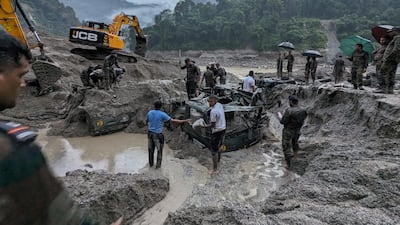The death toll from flooding in India’s Sikkim state has risen to 14 with more than 100 people, including 22 army personnel, still missing.
Over 20,000 people have been affected by the flooding, which occurred after heavy rain over South Lhonak Lake caused the Teesta River's water levels to rise on Wednesday.
Several towns located in the Teesta basin were also flooded after the river rose by up to six metres.
Dozens of bridges collapsed and part of a motorway linking Sikkim to the rest of the country was swept away.
The 1200-megawatt Teesta Urja hydropower project was also damaged.
“The entire powerhouse is submerged under water and it is too early to assess the damage,” Sunil Saraogi, the executive chairman of the project, told local media.
About 3,000 tourists are estimated to be stranded. Authorities have set up 18 relief camps for people affected by the flooding. The army, the National Disaster Response Force and local authorities have launched rescue and relief operations.
Prime Minister Narendra Modi “assured all possible support” to the state “in addressing the challenge”.
The weather department said Sikkim received 101 millimetres of rain in the first five days of October, more than double normal levels, triggering floods worse than one in October 1968 in which an estimated 1,000 people were killed.
The department has predicted heavy rain over the next three days in parts of Sikkim and neighbouring states.
The affected area lies close to India's border with Nepal. Lhonak Lake is at the base of a glacier in the mountains around Kanchenjunga, the world's third-highest mountain.
Flash floods are common during India's monsoon season, which starts in June and usually ends in September. However, climate change is increasing the frequency and severity, according to experts, with a rise in climate-related natural disasters in the Himalayan region that stretches 2,500km through a dozen states.

In August, a video showing eight concrete structures collapsing in Himachal Pradesh went viral on social media in India.
There were no casualties but the collapse came following a series of flash floods, landslides and heavy showers in the state that killed about 400 people over two months.
Himachal Pradesh received 742mm of rainfall in the first 54 days of monsoon, whereas the seasonal average is 730mm.


